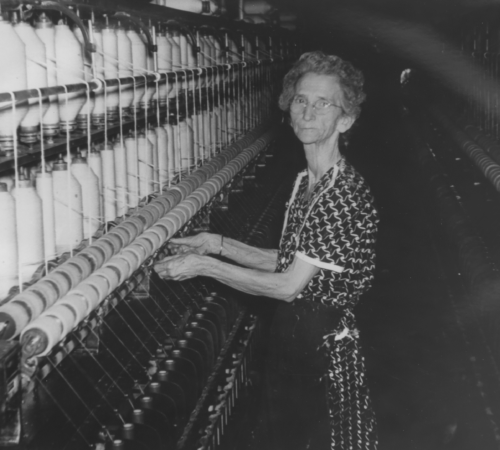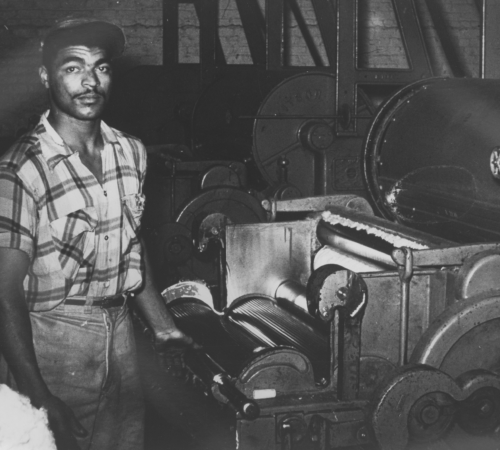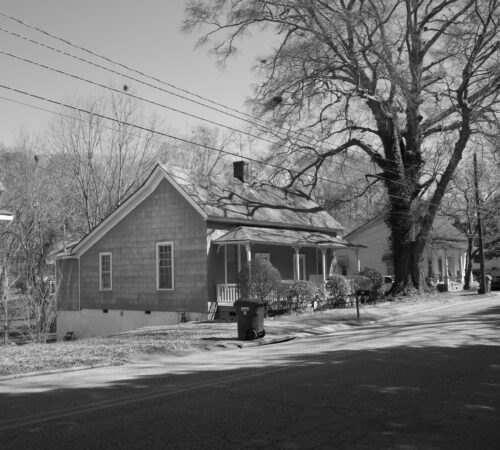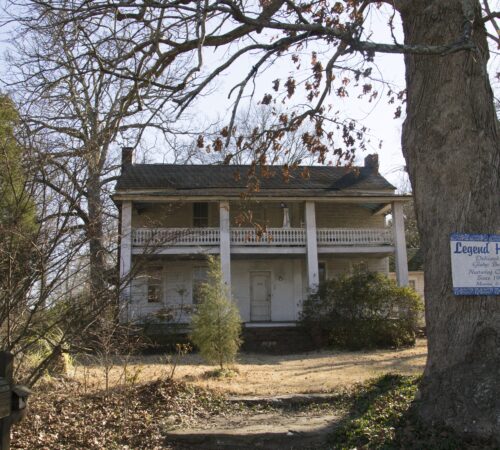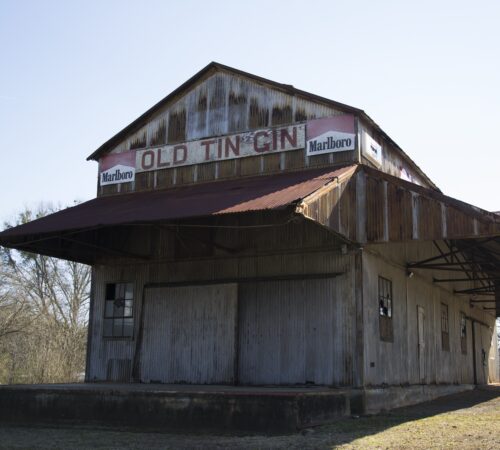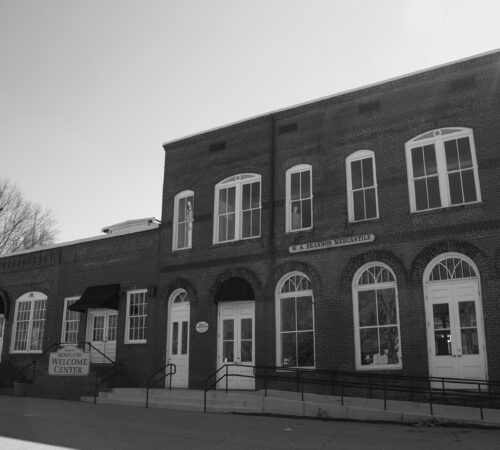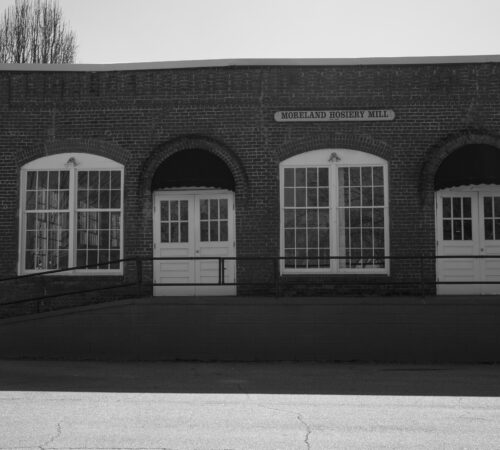These small communities have a huge textile history that hosted two mills and a railroad.
Sargent and Arnco, while never being incorporated as individual towns, hosted a rich textile industry. The first textile mill opened in Sargent in 1886 with a general store being opened not too long after to provide textile workers with basic necessities. The last of the textile mills closed in 2001 due to increased international competition.
Visit
Places to See
The following properties are not open to the public, but you can view them from the exterior to learn more about the buildings that supported the textile industry here.
- Arnco Mills and Mill Village, 229 Arnco 3rd Street: Located in an unincorporated area just north of Newnan on Highway Alt 27/State Route 16 and Old Carrollton Road, Arnco Mills opened in 1927. Seventy-five employee homes were also constructed and five homes were built for the mill superintendent and overseers.
- Wahoo Manufacturing Company/Arnall Mill and Mill Village, Henry Bryant Road: In 1907, Willcoxon Manufacturing constructed a new mill just north of the original mill site named Wahoo Manufacturing Company and later Arnall Mill. In the 1920s and 1930s, the owners of Arnall Mill built additional mill village housing in an area known as “New Town” in Sargent. These mill village homes were of various designs, including shotgun homes, saltbox homes, and gable-front cottages, common in mill villages of the era. Certain streets of the mill village were dedicated to shotgun homes and others to gable-front cottages. The size of the home rented to an employee was dependent on the job skill and job level the employee held within the company. Slightly removed from the main village, on Bridges Street off Railroad Street at the western edge of the mill village, were the homes built for the mills African American employees. These homes followed the same pattern as the other homes in the village with little to no ornamentation and no formal landscaping.
- Wilcoxon Manufacturing Company and Mill Village, Henry Bryant Road: In the late 1880s, J.B. Willcoxon, H.J. Sargent, and George Sargent built the first mill to produce cotton textiles, under the name Willcoxon Manufacturing Company. Mill village homes were also built to house the mill employees. A fire destroyed the mill in 1906 however, the stone foundation of the mill still exists. Most of the homes in the mill village still stand in an area referred to as “Old Town” in the northern portion of Sargent. These simple unadorned homes were typical of mill village homes of the era.
History
The small industrial communities of Sargent and Arnco have a substantial textile history. Both communities were named for prominent businessmen in the area’s cotton textile industry. Sargent was named in honor of H.J. Sargent and George Sargent, partners in Willcoxon Manufacturing Company. The name Arnco is a merger of the names Cole and Arnall, two other prominent mill families in the area. These neighboring areas were an important location for cotton textile manufacturing in Coweta County. Different from the other mill communities, the communities of Sargent and Arnco were further away from the nearest cities and were never incorporated as individual towns.
Willcoxon Manufacturing Company opened a cotton mill in 1886 in Sargent to manufacture cotton rope. John B. Willcoxon, Harrison J. Sargent, and George Sargent, partners in the company, built a four-story brick building on Wahoo Creek at the site of an old gristmill. The spinning machines were powered by water from the creek. Later, two additional buildings were added at the site to serve as warehouses. In 1906, the original mill building was struck by lightning and burned down and a new mill building was constructed in 1907.
The workforce at Willcoxon Manufacturing Company was made up of men, widows of Confederate Veterans, and children as young as 5 years old. In 1888, the company was purchased by Henry Clay Arnall and Thomas G. Farmer and renamed Wahoo Manufacturing Company. Under the new ownership, the operations were expanded to make cotton rope and cotton yarn. In 1919, the Arnall family acquired full ownership of Wahoo Manufacturing Co. and the name was changed to Arnall Mills. Arnall Mills made novelty yarns and around 1929 began making cotton blankets. A weaving room was added in 1930 and additional workers were hired.
The railroad was important to the operation of the mill as blankets were hauled out by freight. The Central of Georgia rail line ran through Sargent from Griffin to Chattanooga and had a freight and passenger depot. To haul the blankets to the freight depot, a special wagon was built and the mill owner purchased a fine team of mules.
In the late 1880s, the first company store was built on Main Street to supply the mill workers with basic necessities. The original store burned down in 1935 and a new building was erected in 1936. The mill workers made purchases at the store and the cost of those purchases was deducted from their weekly paychecks. Mill workers and their family members were able to receive services from the town doctor by paying a doctor tax of 50 cents a week.
By 1926, there was a need for additional outlets for the large amount of cotton yarn made at Arnall Mill, and Arnco Mills was opened near Sargent to fill that need. The name Arnco, a combination of Arnall and Cole the last names of the mill president and vice president combined, was given to the new village built to house the mill workers. Seventy-five employee homes were constructed and five homes were built for the superintendent and overseers. Construction of the mill and mill village started in the summer of 1926, operations began at Arnco Mills in May of 1927, and Arnco became its own unincorporated town. The mill first made cotton blankets known as American cotton blankets and later made part-wool blankets. Throughout the early twentieth century, the mill village was expanded, more houses were built including segregated housing for African-American workers and a baseball field was added. The two mills and villages were entirely separate entities and the companies encouraged friendly competition between the two.
By the early 1930s, due to low wages and deteriorating labor conditions, nearly 44,000 Georgia workers participated in the General Textile Strike of 1934, including many from the Sargent and Arnco areas. The first strikers to be arrested were at the nearby East Newnan Cotton Mills and Arnall Mills in Sargent. The National Guard arrested strikers and took them to Fort McPherson in military trucks where they were forced to live outside until the strike was over. Some of the Arnall Mill employees who supported the strike efforts returned to work at the mill, others were blacklisted from the industry, and some left town to find work elsewhere.
In 1964, Bibb Manufacturing purchased Arnall and Arnco Mills and mill village to manufacture blankets from cotton and synthetic fibers. The company made improvements, modernized the machinery, and raised the pay for employees and the company store was closed. The company also built a 98-acre lake to furnish water for wet finishing blankets and for recreation use. In 1970, the mill village homes were sold to private individuals, many of whom were mill employees. The old company store was used as a recreational facility for mill employees. In 1986, Bibb closed Arnall Mills and moved its operations to Arnco Mill. Arnco Mill continued operations producing sheets, pillowcases, and other cotton items. In 1996, Bibb Companies went through a bankruptcy reorganization and were unable to recover economically. In 1998, the company was sold to the Dan River Corporation of Virginia. In February 2001, due to low-priced textile imports from Asia and the growing economic recession in the United States, Dan River Co. announced the closing of Arnco Mills.
Charter Trail Members
Resources to Explore
Click on the following links to learn more about this region.
Back to Community List
Email the Trail at wgtht@westga.edu or visit our Contact Us page for more information.

